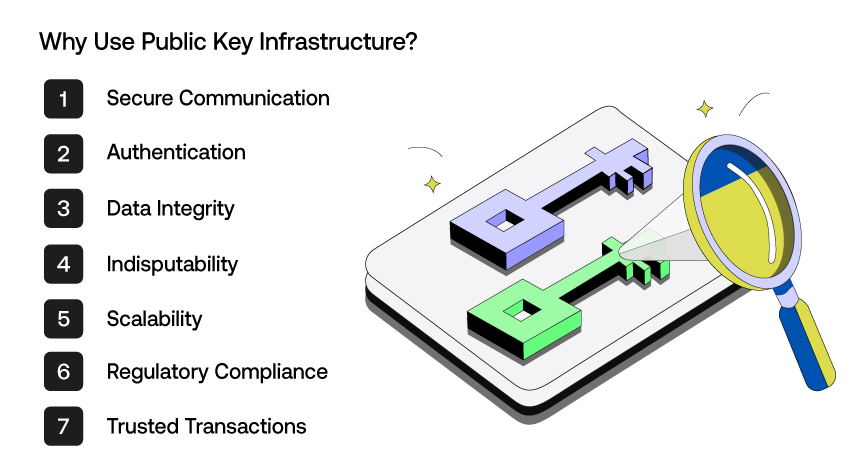
Disclaimer: The information provided in this article is for educational purposes only and should not be considered as financial advice.
Public key infrastructure, or PKI for short, may seem confusing and something most people involved in crypto and web3 may not think they need to understand. However, it is a vital cornerstone of communication security and data protection. What role do they play, how do they work, and why should we use them? Let’s embark on demystifying its inner workings and significance.
Table Of Contents
What is PKI?

Public Key Infrastructure (PKI), revolves around a fundamental concept – using pairs of keys for secure communication and data protection. It may arouse confusion for beginners since asymmetric encryption seems to also embody this concept. We’ll highlight the differences a little later.
In PKI, each person possesses a public key and a private key. The public key, as the name implies, can be openly shared with anyone, while the private key is kept confidential and private (hence the name). Data encrypted with a public key can only be decrypted with its corresponding private key, ensuring that only the intended recipient can access the information.
PKI plays a crucial role when it comes to authenticating users, websites, and devices, adding a layer of trust to digital interactions.
How Does It Work?
Public Key Infrastructure relies on the principles of asymmetric cryptography. Users have two related keys- a public key and a private key. When a user initiates secure communication or data exchange, they share their public key with the intended recipient.
This public key is used to encrypt the data, ensuring that only the recipient, who possesses the corresponding private key, can decrypt and access it. This asymmetric encryption process guarantees confidentiality and data safety.
PKI also incorporates digital certificates issued by trusted Certificate Authorities (CAs) to verify the authenticity of public keys, establishing much-needed trust in the digital world.
PKI VS Asymmetric Encryption
- PKI (Public Key Infrastructure) – A comprehensive system for managing digital certificates and keys, ensuring secure communication, authentication, and data protection. It includes various components, including digital certificates and certificate authorities.
- Asymmetric Encryption – A specific cryptographic technique within PKI that uses pairs of public and private keys to encrypt and decrypt data during transmission. It is a part of PKI, emphasizing data security while in transit.
PKI Certificates
We mentioned PKI having a digital certificate issued by a trusted third party, but what purpose does it give? These certificates are digital documents issued by trusted Certificate Authorities (CAs) to validate the authenticity of public keys. They serve as a digital passport, confirming that the associated public key indeed belongs to the whomever it claims to represent.
PKI certificates contain essential information, including the public key, details about the certificate holder, the certificate’s expiration date, and the digital signature of the certificate authority. This signature supports the certificate’s legitimacy and the CA’s endorsement.
With these certificates, PKI ensures that online transactions and communications are secure and that the entities involved can be trusted.
Certificate Revocation
PKI certificates are typically issued with an expiration date, which ensures that they don’t remain valid indefinitely. However, there are cases where a certificate needs to be revoked before its scheduled expiration, and this is where certificate revocation comes into play.
The CA can revoke digital certificates for a few reasons, with the most common ones being:
- Key is Compromised: If the private key associated with a certificate is compromised, the certificate holder should notify the CA, and they will then revoke the certificate to prevent unauthorized access.
- Certificate Holder’s Request: A certificate holder may request revocation in cases such as a suspected security breach, a change in their status, or if they no longer require the certificate.
- CA Decision: If the CA discovers any irregularities, policy violations, or other security concerns related to a certificate, it may choose to revoke it.
Why Use Public Key Infrastructure?

We’ve established that PKI is integral to data security, but what exact benefits does it provide?
- Secure Communication: PKI enables strong encryption, ensuring that data shared over networks remains safe and tamper-proof.
- Authentication: PKI’s use of digital certificates verifies the identity of participants, minimizing the chances of impersonation or fraud.
- Data Integrity: By confirming the integrity of transmitted data, PKI protects against unauthorized changes.
- Indisputability: PKI supports digital signatures, making it impossible for parties to deny their actions in online transactions.
- Scalability: PKI adapts seamlessly to growing digital environments, making it suitable for organizations of all sizes.
- Regulatory Compliance: PKI aligns with various data protection and privacy regulations, ensuring legal compliance.
- Trusted Transactions: PKI’s relationship with Certificate Authorities enhances the credibility of online exchanges.
Where is It Used?
PKI and the use of private and public keys are seen throughout the digital sphere in areas such as:
- Secure Communications: Secure emails, enabling the encryption of messages, various applications to protect sensitive information during transmission.
- Web Security: SSL/TLS certificates, safeguarding online transactions, user data, and the trustworthiness of websites.
- Authentication: User identity verification in various online services, such as VPNs, remote access, and Single Sign-On (SSO) systems.
- Digital Signatures: Digitally signing documents and contracts.
- Government and Healthcare: Securing government data such as healthcare records.
- IoT Security: Securing the Internet of Things (IoT) devices (smart devices, connected wearables, etc.,) and communication channels.
Conclusion
The versatile system of PKI and its reliance on digital certificates and asymmetric encryption, not only ensures secure communication and user authentication but also serves and cornerstones of data protection and security.
PKI’s significance extends far beyond the realm of technology. It has become an important element for legal compliance as well as safeguarding against cyber threats.
Related Articles
Air-Gapped Wallets – Are They the Safest?
Most Common Web3 Scams and How to Avoid Them
Sources
What Is Public Key Infrastructure (PKI) & How Does It Work? | Okta

0 comments